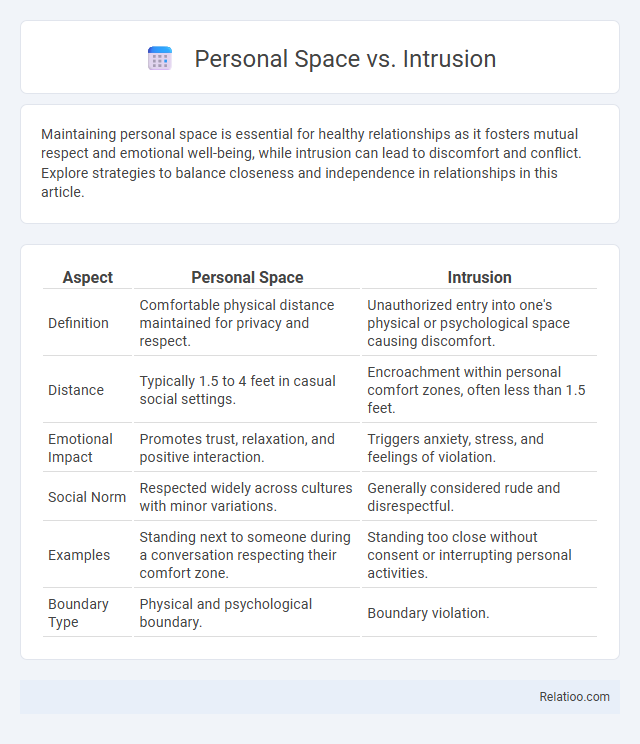Maintaining personal space is essential for healthy relationships as it fosters mutual respect and emotional well-being, while intrusion can lead to discomfort and conflict. Explore strategies to balance closeness and independence in relationships in this article.
Table of Comparison
| Aspect | Personal Space | Intrusion |
|---|---|---|
| Definition | Comfortable physical distance maintained for privacy and respect. | Unauthorized entry into one's physical or psychological space causing discomfort. |
| Distance | Typically 1.5 to 4 feet in casual social settings. | Encroachment within personal comfort zones, often less than 1.5 feet. |
| Emotional Impact | Promotes trust, relaxation, and positive interaction. | Triggers anxiety, stress, and feelings of violation. |
| Social Norm | Respected widely across cultures with minor variations. | Generally considered rude and disrespectful. |
| Examples | Standing next to someone during a conversation respecting their comfort zone. | Standing too close without consent or interrupting personal activities. |
| Boundary Type | Physical and psychological boundary. | Boundary violation. |
Understanding the Concept of Personal Space
Personal space refers to the physical and emotional boundaries individuals maintain to feel comfortable and secure in social interactions. Intrusion occurs when someone enters this personal zone without permission, causing discomfort or anxiety. Overstepping involves not only violating physical space but also disregarding emotional limits, leading to potential conflict and a breakdown of trust.
The Psychology Behind Personal Boundaries
Personal space is a psychological boundary essential for emotional comfort and self-identity, serving as a nonverbal communication tool that signals the need for privacy and respect. Intrusion occurs when these invisible boundaries are violated, leading to feelings of vulnerability, anxiety, or anger due to perceived threats to one's autonomy. Overstepping personal boundaries often disrupts trust and interpersonal relationships by blurring the lines between respectful interaction and invasive behavior, highlighting the critical role of personal boundaries in mental well-being and social harmony.
Types of Intrusion in Daily Life
Types of intrusion in daily life include physical intrusion, such as uninvited touching or invading someone's personal distance, and informational intrusion, where private data or conversations are accessed without consent. Emotional intrusion occurs when someone imposes opinions or judgments, disregarding personal boundaries and autonomy. Social intrusion involves interfering in relationships or personal matters, often leading to discomfort and a sense of boundary violation.
Cultural Differences in Personal Space
Personal space varies significantly across cultures, influencing how individuals perceive intrusion and overstepping boundaries. In some cultures, close physical proximity is a norm and seen as a sign of warmth, while in others, maintaining a larger personal space is crucial for comfort and respect. Understanding these cultural differences helps you navigate social interactions more effectively, minimizing misunderstandings and respecting others' spatial boundaries.
The Impact of Technology on Personal Boundaries
Technology significantly blurs the lines between personal space, intrusion, and overstepping, as constant connectivity enables others to access your private life anytime. Digital communication tools, social media platforms, and location-sharing apps intensify the risk of boundary violations by making it easier to intrude without physical presence. Establishing clear digital boundaries and understanding privacy settings are essential to protecting your personal space in the modern technological landscape.
Recognizing Signs of Personal Space Violation
Recognizing signs of personal space violation involves observing your own discomfort or unease when someone stands too close or touches you unexpectedly. Physical cues like stepping back, crossing arms, or avoiding eye contact often indicate intrusion or overstepping boundaries. Your awareness of these subtle signals helps protect your personal space and maintain respectful social interactions.
Effects of Intrusion on Mental Health
Intrusion into personal space can cause significant stress, anxiety, and feelings of vulnerability, negatively impacting mental health by triggering hypervigilance and reducing a sense of safety. Persistent overstepping of boundaries leads to emotional exhaustion and diminished self-esteem, often resulting in increased irritability and depression. Understanding and respecting personal space is essential for maintaining psychological well-being and fostering healthy interpersonal relationships.
How to Set and Communicate Boundaries
Setting and communicating personal boundaries involves clearly defining physical and emotional limits to prevent intrusion and overstepping by others. Use assertive language and non-verbal cues, like maintaining appropriate distance, to express discomfort or refusal respectfully. Consistent reinforcement of these boundaries through calm, direct communication helps others understand and respect your personal space.
Responding to Personal Space Intrusion
Recognizing when someone invades your personal space is crucial for maintaining comfort and boundaries. You can respond assertively by verbally expressing your need for distance or using nonverbal cues like stepping back to signal discomfort. Clear communication and setting firm limits help prevent overstepping and protect your personal space effectively.
Creating Respectful Environments for Everyone
Establishing clear boundaries around personal space is essential for fostering respectful environments where individuals feel safe and valued. Recognizing the difference between respectful proximity and intrusion helps prevent discomfort and preserves personal autonomy. Encouraging open communication about boundaries reduces instances of overstepping and enhances mutual respect in diverse social and professional settings.

Infographic: Personal Space vs Intrusion
 relatioo.com
relatioo.com